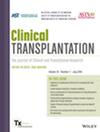Long-Term Outcomes of Belatacept Versus Tacrolimus Following T-Cell Depleting Induction in Adult Kidney Transplantation
Abstract
Background
Belatacept shows promise as an alternative immunosuppressant without the nephrotoxicity of calcineurin inhibitors. Avoiding nephrotoxicity is important with the expanding use of organs at risk of marginal graft function. To date, no large studies have compared belatacept directly with tacrolimus after T-cell depleting induction in renal transplantation.
Methods
The Standard Transplant Analysis and Research file was used to compare adult kidney transplant recipients induced with T-cell depleting agents treated with belatacept to propensity score-matched recipients treated with tacrolimus between August 10, 2011 and June 29, 2023. Kaplan–Meier survival analysis was used to compare death censored graft survival, patient survival, and time to acute rejection.
Results
During the study period, 4391 adult kidney transplant recipients were treated with belatacept. Estimated GFR improved for belatacept-treated patients through year 9, whereas it decreased for the control group through year 10. Belatacept-treated patients had a higher rejection rate at 5 years (21% vs. 15%, p < 0.001). Death-censored graft survival did not differ between groups (p = 0.383). Among patients who had rejection, death-censored graft survival was superior in belatacept-treated patients at 5 years (70% vs. 60%, p = 0.026). Overall, patient survival did not differ between groups (p = 0.120).
Conclusions
This is the largest longitudinal study to compare outcomes of belatacept versus tacrolimus-based therapy following T-cell depleting induction. Belatacept was associated with improved graft function despite an increased acute rejection rate. There was no difference in overall graft or patient survival compared to tacrolimus. This study suggests that belatacept-based therapy is not inferior to tacrolimus-based therapy following T-cell depletion.

 求助内容:
求助内容: 应助结果提醒方式:
应助结果提醒方式:


